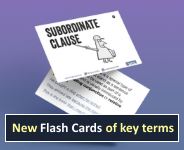Glossary: lexeme
Explanation
The dictionary entry of a word. E.g. the nouns cat and cats belong to the lexeme cat, and the verbs sing and sings belong to the lexeme sing.Englicious contains many resources for English language in schools, but the vast majority of them require you to register and log in first. For more information, see What is Englicious?

